Archived Storm Damage Blog Posts
Summer Rains in East Tennessee
7/12/2022 (Permalink)
We all love the warmer weather, fresh cut lawns, and summer flowers but we all know, spring in the South brings a lot of rain! Summertime can be challenging to our homes, businesses, and landscaping. Many times, the rain can bring backed up sewage, holes in our roofs that lead to water damage and flooding the basements. SERVPRO of Greene County thought it would be important to share some safety tips with you regarding heavy rains and flooding so you can keep the water mitigation to a minimum this season.
Heavy Rain Tips
- Check your Roof-Look for current damage and areas that look vulnerable to leaks. Repair these as soon as possible. If need be, call a roofer to perform the inspection and the repairs.
- Trim Foliage-Plants and trees with overgrown branches can pose a danger to your household in harsh winds and rain.
- Waterproof Windows-Check the edges of your windowsills to see if they need a waterproof sealer or rubber on the edges.
- Clear out Gutters-It is important that these are clear in case of heavy rain to prevent any possible flooding. You should check your gutters a couple of times throughout the year as the wind tends to carry leaves and debris into the gutters blocking the water from flowing freely.
Remember, it is very important to keep an eye on these things because a small leak can cause a lot of damage. SERVPRO of Greene County is always here to help! Call us at (423) 638-1104.
Be Prepared Before The Storm Comes
3/29/2022 (Permalink)
Thunderstorms can be dangerous and not taken very seriously at times. Most thunderstorms produce lightning and other dangerous weather conditions such as tornadoes, strong winds, hail, and flooding.
In the Greene County, TN area we tend to get a little bit of heavy rain and heavy thunderstorms. Here are some tips for you and your family to be prepared before, during, and after this year’s storm season.
What to do before a thunderstorm
- To begin preparing, you should build an emergency kit and make a family communications plan.
- Remove dead or rotting trees and branches that could fall and cause injury or damage during a severe thunderstorm.
- Postpone outdoor activities.
- Secure outdoor objects that could blow away or cause damage.
- Get inside a home, building, or hard-top automobile (not a convertible). Although you may be injured if lightning strikes your car, you are much safer inside a vehicle than outside.
- Remember, rubber-soled shoes and rubber tires provide NO protection from lightning. However, the steel frame of a hard-topped vehicle provides increased protection if you are not touching metal.
- Shutter windows and secure outside doors. If shutters are not available, close window blinds, shades, or curtains.
- Unplug any electronic equipment well before the storm arrives.
- Lightning Risk Reduction When Outdoors
SERVPRO of Greene County hopes everyone gets ready for this upcoming storm season and when they do come, SERVPRO of Greene County is here to help in anyway we can.
SERVPRO to the Rescue
3/8/2022 (Permalink)
Most of the time when our area gets heavy rain, SERVPRO tends to get a lot of calls for flooding. We get so many sometimes that we have to make a list to ensure each job gets the proper attention and professionalism they deserve. Our team is good at keeping track of each job to make sure our customers are satisfied in the end. The main calls we get around this time are flooded basements, crawlspaces, and garages. One of the worst calls we got was from a lady who woke up to no heat in her house. She stated she immediately headed for the basement door, as her furnace was located down there. Once she opened the door, she saw water was almost up to the door. She was in total shock. Her entire basement was filled with rainwater. Imagine having about 8 feet of water in your basement. This poor lady had not only her furnace down there, but also her washer and dryer, her water heater, and all her storage items like Christmas décor and old photobooks in totes. She was so devastated. I think anyone would be in that situation. Thankfully, SERVPRO showed up within an hour to help her. Once we pumped all the water out, we found the issue to this enormous amount of water. One of the basement windows was broken. We got many inches of rainfall that night and the creek beside her house had overflowed and came down her back yard, right into her basement. She may have not been able to salvage the basement items, but she was glad the water didn’t seep up into the 2nd level of her house.
Focus Areas to Check For Storm Damage
11/13/2021 (Permalink)
Focus On These Four Areas
Severe weather can lead to significant property damage, and unless your facility has an excellent exterior maintenance schedule, you may wind up with many unexpected expenses. People often have a false sense of security about their buildings, which can result in the absence of concern after a storm. As any storm restoration and remediation company in Greene County, TN, may explain, inspections after any storm are vital to the protection of your building and budget. If you are not familiar with inspecting your facility after a storm, then try and focus on the four following areas.
- Walls
A significant aspect of keeping a building maintained is ensuring its structural integrity. While you may not see any apparent storm damage while walking your property, look closely at the walls, especially toward the foundation and roofline. If you notice any cracking, splits, or separation, then you may have a foundation problem. Sometimes rainwater settles near the footing of a building, causing soil displacement, which shifts the foundation of the building, resulting in damaged property. - Windows
When performing exterior maintenance and inspections, be sure to examine the windows around the property. Windows often have a shorter lifespan than the rest of the materials used in your property. While the pane may be intact, the frame or the sealant used for installation can fail over time, leading to water damage in the property. - Cladding or Siding
While cladding is useful for the protection of the exterior of your facility, it can damage easily. High winds can peel the material away from the building. Hailstones can puncture the material. Look for displaced seems and holes as you walk the property. - Roof
A thorough building inspection should include the roof. Many commercial roofs are flat and prone to water damage. Look for damaged sheeting and failing seals as you would with windows.
Especially during this time of year, when severe weather is typical, it is crucial to focus on exterior maintenance. If you need more suggestions for inspection points, then contact a local professional.
Call SERVPRO of Greene County at 423-638-1104 if you find yourself with any kind of storm damage! We are here to help 24 hours a day 7 days a week 365 days a year!
Are You Ready?
10/20/2021 (Permalink)
Is Your Home Ready for Fall and Winter Storms
Cold weather and winter storms can have a huge impact on your home or business if you are not properly prepared. Whether it is heavy rains and wind, freezing temperatures, sleet or snow, all can cause serious and costly property damage. Take steps to be prepared and help take the sting out of the winter blues.
- After winter storms check your property for downed tree limbs and branches. Downed limbs can cause damage to your property and lead to possible water damage issues.
- Roofs, water pipes and gutters should all be inspected to ensure they are in proper order. Gutters should be clear of debris and directed away from buildings. Leaves and other obstructions can cause a damming effect, which can lead to roof damage and interior water problems.
- Inspect property for proper drainage to alleviate flood hazard potential.
- Inspect all handrails, stairs, and entryways to address and correct potential slippery or hazardous areas. Install mats or non-slip surfaces and post cautions signs.
- Protect water pipes from freezing by simply allowing water to drip when temps fall below freezing. If pipes are under cabinets, leave the cabinet doors open.
- Consider turning outdoor faucets off at the main valve. Once shut remember to drain the outdoor faucet.
When winter weather strikes and causes a disaster, call SERVPRO to strike back!
Remember Your First Snow Storm
9/3/2021 (Permalink)
Can you remember the first time you experienced a snowstorm? I was 5-7 years old living with my parents and older brother in Jonesborough, TN when I experienced my very first blizzard. My entire street and neighborhood were out of power for a total of 5 days. I remember on the first day, my dad grabbing his old kerosene heater from the shed and telling my mom to pile clothes on us for the night. Little did we know that this was going to be the longest week of our lives. It snowed so heavy that no one on my street could make it out of their driveway. We all were running out of supplies and fuel. So, on the third day I remember seeing an older gentleman and two younger men in a big truck with a trailer attached to the back. They were attempting to make a store run for everyone in the neighborhood. What an amazing act of kindness I thought. It took these guys 6 hours to make it back from a store that was normally 30 mins away. I had never been in a situation like that since then. It was truly scary. But I was so grateful for those men that risked their lives that day.
Watches vs Warnings
9/2/2021 (Permalink)
Summer Storm Watches vs Warnings
Be alert! No matter where you are in Northeast Tennessee, you’re at risk for stormy weather. Know the differences between emergency weather watches and warnings and pay attention to local weather statements.
Severe Storm Watch: Means atmospheric conditions are favorable for a particular severe weather hazard within the next several hours. Stay informed and have a plan. A Tropical Storm Watch is issued when a tropical cyclone with winds of 39-73 mph may affect the area within the next 48 hours, and a Hurricane Watch goes into effect when conditions with winds of 74 mph or more is possible within the next 48 hours.
Severe Storm Warning: Indicates a particular severe weather hazard is imminent or occurring. Promptly take action to protect life and property. A Tropical Storm Warning advisory is triggered when a tropical cyclone with sustained winds of 39-73 mph is foreseen within 36 hours or less, and when sustained winds of 74 or more are expected within 36 hours or less, it’s upgraded to a Hurricane Warning.
Stay safe! You and your family’s (or employee’s) physical safety and health are priority. You can learn about summer storm watches and warnings from the National Weather Service (NWS). The National Oceanic and Atmospheric Administration’s (NOAA)/NWS Storm Prediction Center shares regional weather warnings, and the National Hurricane Center (NHC) tracks tropical storms and hurricanes.
Storm Dangers From Standing Flood Waters
3/30/2021 (Permalink)
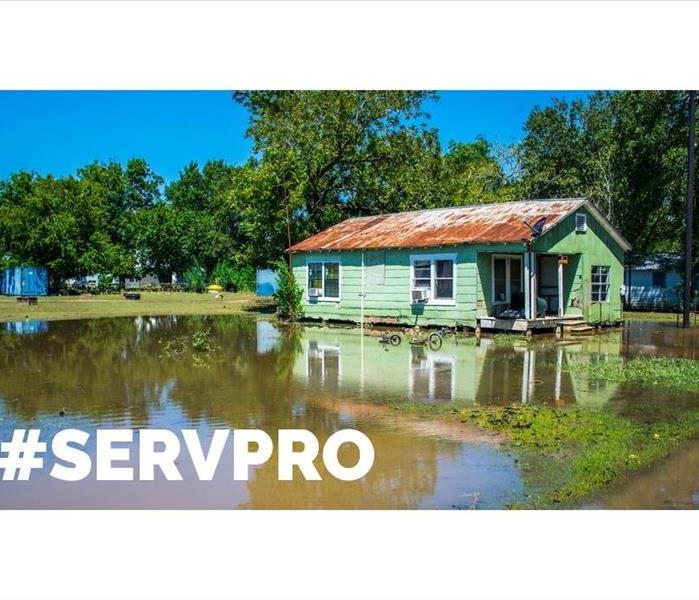 storm flooded home
storm flooded home
Storms and hurricanes devastate different regions every year. Unfortunately, some of the biggest dangers caused by storms can occur after the storm has already passed. In addition to a lack of supplies and road closures, the standing flood water resulting from storms can cause serious health risks. Here are some of the most severe problems floods can bring.
Health Dangers
Standing flood water is teeming with health risks. The CDC has a section detailing all the possible diseases that become more likely in the event of a storm disaster, including Norovirus and the West Nile Virus. Bacterial infections and diseases become a greater possibility because flood water can infect everything it touches. This can include anything from articles of clothing to the toys that children play with. For this reason, it is incredibly important not to drink or eat anything that has been contaminated by standing flood water, and to always wash hands as often as possible- especially before meals. In addition, open wounds pose a far greater risk of becoming infected as a result of storm waters. If possible, keep open wounds out of the water or cover with waterproof bandages.
Physical Hazards
Disease isn't the only invisible hazard that can exist within standing water. Murky water can conceal dangerous insects or even threatening animals beneath the surface. Much of this depends on the location of the storm, but it's not unheard of for alligators to make use of a new habitat resulting from a storm. In addition, much of the physical damage caused by a storm is still present in the water. This can include broken glass or sharp metal which might be impossible to see before it causes injury. On top of that, storms frequently cause damage to power lines. These can lead to a risk of electrocution in standing water. Flood water itself poses the possibility of causing drowning, whether people are in their cars or trying to swim across.
If you need storm damage repair or water damage cleanup, contact the team at SERVPRO of Greene County today at 423-438-1104.
Storm Dangers From Standing Flood Waters
3/24/2021 (Permalink)
Storms and hurricanes devastate different regions every year. Unfortunately, some of the biggest dangers caused by storms can occur after the storm has already passed. In addition to a lack of supplies and road closures, the standing flood water resulting from storms can cause serious health risks. Here are some of the most severe problems floods can bring.
Health Dangers
Standing flood water is teeming with health risks. The CDC has a section detailing all the possible diseases that become more likely in the event of a storm disaster, including Norovirus and the West Nile Virus. Bacterial infections and diseases become a greater possibility because flood water can infect everything it touches. This can include anything from articles of clothing to the toys that children play with. For this reason, it is incredibly important not to drink or eat anything that has been contaminated by standing flood water, and to always wash hands as often as possible- especially before meals. In addition, open wounds pose a far greater risk of becoming infected as a result of storm waters. If possible, keep open wounds out of the water or cover with waterproof bandages.
Physical Hazards
Disease isn't the only invisible hazard that can exist within standing water. Murky water can conceal dangerous insects or even threatening animals beneath the surface. Much of this depends on the location of the storm, but it's not unheard of for alligators to make use of a new habitat resulting from a storm. In addition, much of the physical damage caused by a storm is still present in the water. This can include broken glass or sharp metal which might be impossible to see before it causes injury. On top of that, storms frequently cause damage to power lines. These can lead to a risk of electrocution in standing water. Flood water itself poses the possibility of causing drowning, whether people are in their cars or trying to swim across.
If you need storm damage repair or water damage cleanup, contact the team at SERVPRO of Greene County today at 423-438-1104.
The Difference Between Mitigation and Restoration
11/16/2020 (Permalink)
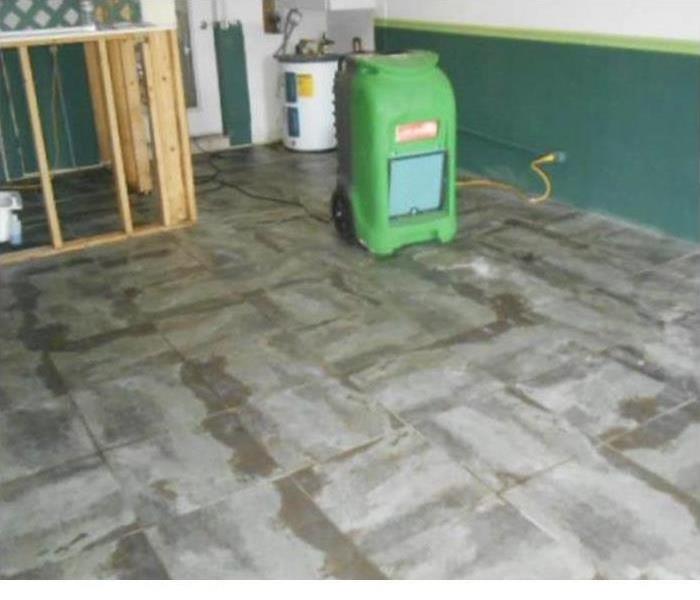 Storm mitigation in a commercial building
Storm mitigation in a commercial building
What Does That Mean?
When unwanted water disrupts operations at your Greeneville, TN, business, it can be an overwhelming experience from potential lost revenue to dealing with the cleanup itself. To get back on track and ensure that no future issues arise, it is best to contact a flood cleanup company. The right professional will provide both water damage mitigation and restoration services, but what does that mean?
Mitigation
A restoration company always performs mitigation services first. This involves using industrial equipment and techniques to prevent further damage and prepare the affected areas for repairs. The process often involves:
- The removal of damaged materials, such as drywall, and furniture.
Sorting, cleaning and disinfecting salvageable items. - A thorough inspection if the structure to assess stability and locate any hidden damage.
- Water extraction and drying using commercial-grade equipment.
Preventing additional damage by boarding up broken windows or applying a tarp to a damaged roof.
During the cleaning process, the experts will use an array of cleaning methods for your belongings both on- and off-site. Trained to save instead of replace, many items that may seem like a lost cause can likely be cleaned, including electronics, documents and carpeting.
Restoration
Once the flood cleanup company completes the temporary fixes and the property is dry, the real work begins. Restoration is a much lengtheir process since it may involve rebuilding portions of the building. The extent of damage will determine the amount of work needed and how long it will take, but the services often include wall and flooring replacement, mold remediation and roof repairs. Once the restoration is complete, humidity and moisture testing is conducted to ensure no problems linger.
While hopefully, you won't need a flood cleanup company, if you do, understanding the process beforehand can make the situation go more smoothly. Ensuring you secure a company that provides both can make the claim process and restoration itself easier to handle.
5 Things To Know About Hail Damage
10/23/2020 (Permalink)
 Hail damage on roof in Greeneville, TN
Hail damage on roof in Greeneville, TN
Understanding What To Expect From Hail And Other Storm Damage
When dealing with hail damage to roof areas on your Greeneville, TN, home, you may feel overwhelmed. Fortunately, understanding what to expect from hail and other storm damage can help.
1. Wind Can Influence It
The type of wind that comes with a hail storm influences where and how hard the hail falls. Heavier winds can throw hail into areas a regular storm might not reach.
2. The Roof Surface May Affect the Type of Damage
The damage caused by hail can depend on the type of roofing on your home. Shingles may crack or chip, while a metal roof may dent. If you're not sure what hail damage might look like on your home, it’s best to contact a professional.
3. Damage Can Vary
In many cases, the appearance of hail damage to roof shingles may vary depending on how exposed a section of the roof was to the storm. This is why it’s best to look over the whole roof during an inspection. Some areas may be completely fine while others suffered visible damage.
4. Repairs Should Be Made Quickly
If the roof is damaged, it’s best to make repairs as quickly as possible. It’s also a good idea to cover any damage with a tarp or plyboard to help protect the space from further problems until repairs can be completed.
5. A Professional Can Help
Fortunately, a local storm damage restoration service can help with your hail damage repair needs. These professionals should have the training and tools needed to assess the damage, formulate a repair place, and restore your roof.
When dealing with hail damage to roof sections on your home, it’s important to remember that wind, the roof type, and other factors may make it hard to tell how much damage your home has taken. Repairs to your roof should be made as quickly as possible, but a professional restoration service can help.
How Do You Prepare Your Business for High Winds?
9/8/2020 (Permalink)
Protect Your Business From High Winds
Do you know what you would do if a hurricane was going to impact your business in Greeneville, TN? Having a plan to prevent hurricane damage to your business can be valuable before a hurricane or storm occurs.
1. Keep Windows Protected
Prior to a hurricane, tornado or strong storm, it's generally wise to protect your building's windows in order to ensure that water and debris don't enter your building. When building your business, especially if you live in an area that is prone to hurricanes, it can be helpful to install storm shutters. However, if your building does not already have storm shutters and you know that a hurricane or strong storm is likely to impact your area, you can use plywood to prevent windows from easily shattering.
2. Inspect the Exterior of Your Business
In addition to covering your windows before a storm, it can also be helpful to inspect the exterior of your business before a storm begins. Often, hurricane damage occurs when lightweight items are not anchored down before a storm. These items can become projectiles if high winds occur, and such items can damage your building. If there are any signs, tables or chairs outside of your business, it can be useful to remove them so they don't blow away. Removing debris, such as limbs or branches, can also help to protect your property.
3. Research Mitigation Companies
After a storm, you generally don't want to feel as if you have to pick the first mitigation company you come across. However, if you don't research mitigation and restoration companies before a storm occurs, you may end up choosing an unreliable company. Researching mitigation companies can be useful before a storm, and choosing a mitigation and restoration company can help to accelerate both the mitigation and restoration processes.
By taking steps to protect your property from high winds, it's often possible to avoid hurricane damage. Protecting your windows, inspecting the exterior of your business and researching mitigation companies before a storm are all useful ways you can prepare your business for a storm.
4 Basic Steps in Leaking Roof Repair
9/5/2020 (Permalink)
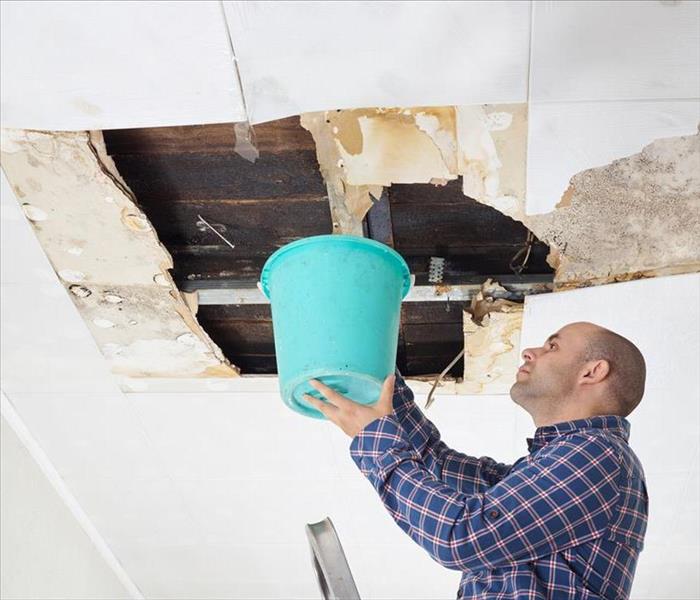 Roof damaged in Albany, TN
Roof damaged in Albany, TN
Steps To Contain Water And Storm Damage
A roof leak may seem like a small concern, but it is one that must be dealt with promptly to avoid more serious and costly issues. Aside from harm to your business’s equipment, supplies, and inventory, a leaking roof is dangerous to your building’s structure, work environment, and employees in Albany, TN. Quick action is necessary to address such a situation. Here are three steps to prevent further problems:
1. Tear out any wet materials. Inspect and assess the location to ascertain the extent of the damage as soon as possible. Insulation and wallboard are building materials that, once wet, will never be the same. Even worse, damp conditions allow and encourage mold growth and possibly insect infestation.
2. Dry and disinfect the area. Mold can grow quickly if given the right environment. After the wet materials have been removed, dry the section with commercial air dryers that circulate air rapidly and promote water evaporation. Use disinfectant to kill bacteria that may have set in.
3. Restore the damaged roof and ceiling. The cause of the roof leak may be missing shingles or flashing or open seams. If you are not able to locate the source, be on location during the next rain or, if practical, spray water on the roof while someone watches from the inside to observe the location of the leaks. To safeguard against future water damage, repair your building in a timely manner.
4. Hire expert assistance. To lessen the disruption to your business operations, secure the services of a professional remediation company to handle such issues. These specialists are trained to identify sources of water damage, restore dryness, and take swift action to halt any further loss.
Don’t wait before taking steps to contain water and storm damage. What might seem like a minor roof leak may become a major problem, leading to final costs much higher than a prompt remedy.
What To Avoid After a House Flood
8/1/2020 (Permalink)
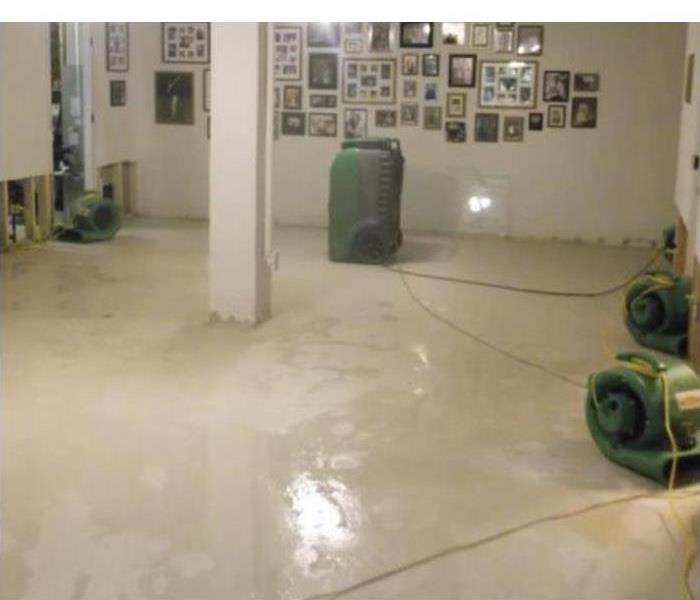 Storm causes flooding in a Jearoldstown, TN home
Storm causes flooding in a Jearoldstown, TN home
If you live in an area where flooding isn't out of the ordinary, you should be prepared to prevent such emergencies. Even with the best efforts, however, you may still encounter floodwater in your home. While there are plenty of things you should do, there is also a list of steps you shouldn't take in the aftermath of these types of incidents. A smart response can spare you a lot of stress and grief.
Don't Hang Out at Home
It can be devastating to watch water rush into your Jearoldstown, TN, house and fill up room after room. The thought of losing your home and possessions can be too much for anyone to bear. Still, safety is your priority. The worst thing you can do is sit in a flooded home and hope you can hold back the water yourself. Instead, do the following:
- Get yourself, family members and pets out of your home as soon as possible.
- Avoid the temptation of grabbing a bunch of belongings; grab only the essentials you can carry.
- Get to a shelter or a safe place.
Don't Re-Enter Your House
Once emergency crews arrive on the scene, let the professionals do their work. Expert flood remediation crews will remove the water and assess the water damage. This includes tearing out flooring, drywall, and other materials. It will include rebuilding where necessary and cleaning up mold. Resist the urge to return to your home and go inside. Do not enter unless you are told it is safe to do so.
Don't Put Off Calling for Help
In all the mayhem that can occur after flood water gets into your house, you may forget a few steps. Aside from filing an insurance claim, contact your mortgage lender. In such an emergency, your lender may let you defer payments for a few months.
The sight of flood water in your house can be a harrowing experience. Be careful not to act rashly, but instead keep these tips in mind.
Flood Safety Tips During and After the Storm
5/5/2020 (Permalink)
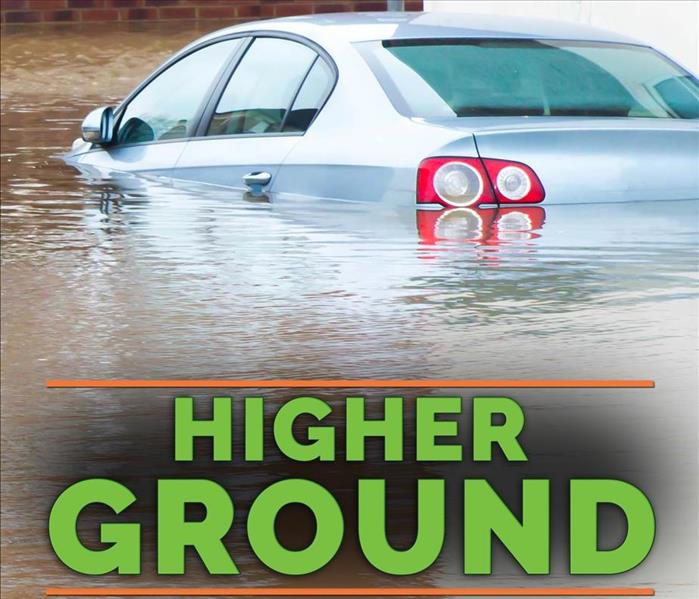 Move to higher ground if possible
Move to higher ground if possible
A major storm can be divided into three sections: before, during, and after the storm. Preparation before a storm involves acquiring insurance, having an evacuation plan, strengthening your resources, and bolstering the defenses of your property. When done right, storm preparation can minimize property damage and reduce serious injuries to family members. If your home in Romeo, TN, could be hit by a flood, then special attention should be paid to flood safety. Measures such as maintaining the roof, fixing cracks in the foundation, cleaning out drainage systems, and putting up strong windows and shutters can be helpful.
Safety Tips During A Storm
A raging can be one of the most frightening moments in a person's life. Everyone in the home should practice these flood safety practices:
- Move to higher ground if possible
- Do not touch floodwaters with bare skin
- Pay attention to compromised electrical systems
- Help those who are vulnerable such as the elderly, sick and young
- Listen to the radio for weather updates
Safety Tips After A Storm
Once a storm has passed, many dangers are still likely to be present. If floodwaters enter a home, they should be considered contaminated. In this case, calling in a qualified storm mitigation franchise should be a priority. Technicians can provide guidance on how to stay safe. Since floodwaters can contain harmful chemicals and sewage water, the waters should be cleaned by workers wearing PPE. Powerful wet vacuums can remove the water efficiently and industrial fans can dry out saturated flooring and contents. Special attention should be paid to areas touched by contaminated water.
Flood safety after a storm also extends to watching out for electrical systems. A shock hazard could exist in areas where water is still standing or has passed through. Also, the structural integrity of the home could be weakened, resulting in weakened floors and walls. A home should be reentered carefully after a destructive storm.
5 Tips for a Workplace Power Outage
3/31/2020 (Permalink)
 It’s important to have back up options for the computers in case of a power outage
It’s important to have back up options for the computers in case of a power outage
5 Tips for a Workplace Power Outage
During a storm, you may experience a power outage at your Jearoldstown, TN, business. A loss of power can not only make it difficult to work, but can also create a hazard for any customers or employees that may be present. Here are five tips you may want to consider for preparing for power outages at your business.
1. Make an Outage Plan
One of the first things you can do is make an emergency plan for power outages. This plan may include the location of lights and emergency kits as well as who to all in various situations. For example, if flooding should occur you may want the number of a storm damage restoration service.
2. Have an Emergency Kit
An emergency kit is important to have on hand as accidents are more likely to occur in the dark. The kit should be well stocked with a variety of medical supplies. You may also want to include a couple of flashlights.
3. Know the Backup Options
It’s important to have back up options for the computers or other devices in case of a power outage. You may choose to have everything stored on an outside server to keep data safe, or to invest in a portable generator which can keep the office supplied with electricity when properly used.
4. Have Safety Lights Installed
It’s important to have safety lights installed around any stairs or exits that may be present. Many of these are battery or solar operated and shouldn’t be affected if the power goes out. One example is that way many exit signs are lit in commercial buildings.
5. Know Emergency Numbers
It’s also important to have a list somewhere containing any emergency numbers you may need. This will help you and your employees contact help quickly should it be required.
When preparing for a power outage at your business you may want to start with an outage plan and share it with your employees. This plan should include all the measures you've taken such as safety lights, emergency kits, backup options, and emergency numbers. Following these tips can help you keep your employees and customers safe.
Here’s How FEMA Can Help You Recover After Getting Storm Damage
11/14/2019 (Permalink)
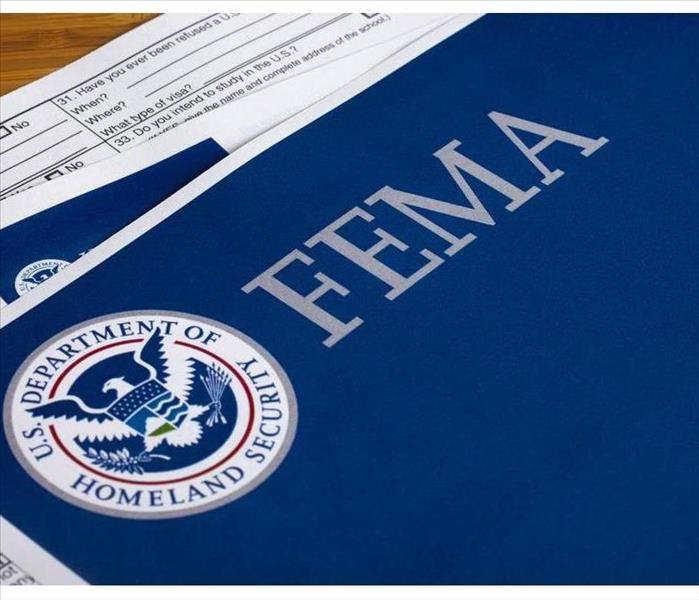 Once a large-scale disaster strikes the area around Albany, TN, one of the first to arrive is FEMA
Once a large-scale disaster strikes the area around Albany, TN, one of the first to arrive is FEMA
Here’s How FEMA Can Help You Recover After Getting Storm Damage
Once a large-scale disaster strikes the area around Albany, TN, one of the first to arrive is FEMA. Many people are often left homeless, and it’s part of their job to help assist with finding shelter and to assess the need for immediate aid. Their inspectors are the front-line troops that all other aid agencies depend on for the most up-to-date information about how devastated an area is and what the federal government can do to assist those who survived the ravages of Mother Nature.
After the Storm
Once the storm has passed, the immediate need is for rescue. This is typically done by local and state authorities. However, in a major disaster, such as a hurricane or widespread flooding, it isn’t uncommon for thousands to be left homeless. FEMA will first help assess which homes are able to be used and which are not safe to reenter. For those structures that are inhabitable, the next step is to meet with the homeowners to discuss what can be done. Questions they’ll ask include
Do you have insurance, including flood insurance?
What other forms of aid can you get?
Who else lives in the home?
How much damage do you have?
Documentation Is Your Friend
Hopefully, you’ve stored important documents in a safe place, such as a waterproof and fire-resistant safe or safety deposit box. If you have pictures of your property before the storm, that’s a big help for your case. They’ll need to see your insurance policies and proof of ownership of all impacted property, both personal and real, before they can consider offering grants. Since regular homeowner’s insurance doesn’t cover flooding in Albany, TN, they can often help cover some of the flood cleanup costs.
Even before FEMA arrives, it’s imperative that you call a storm damage cleanup company that’s experienced in your area. They have experts who can tarp up the undamaged parts of your home to prevent further damage and can begin the restoration process quickly. The sooner it’s done, the sooner your life can get back to normal.
How To Keep Income During Storm Restoration
10/26/2019 (Permalink)
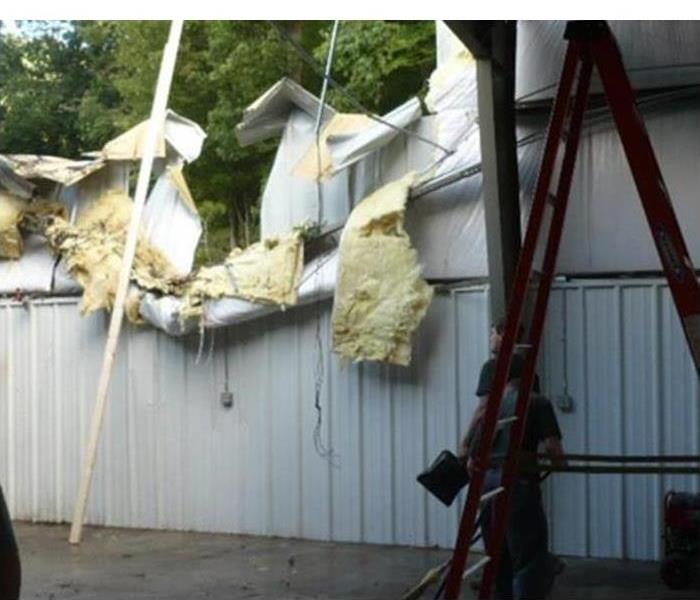 Storm damage to a commercial building in Romeo, TN
Storm damage to a commercial building in Romeo, TN
How To Keep Income During Storm Restoration
Unfortunately, sometimes unexpected disasters occur, damaging property and hurting your business. No matter the cause, as a business owner in Romeo, TN, it's your job to anticipate the worst and make the rebuild easier. Do so by creating an emergency plan that helps with storm damage clean up and eases the loss of income. Here are a few things to consider.
1. What Is Property Insurance?
Sit down with your agent to discuss your company's coverage. What events are included? How much is the deductible? What would happen if you closed business for a while? For example, typically, your plan covers trouble from weather, leaky pipes, sewer damage, and fire. If these situations occur, you'd need to request compensation for lost goods as well as the cost of repairs. It does not, however, cover lost time and revenue. Both of which could have a major impact on your business's success.
2. Does Your Business Need To Temporarily Close?
While the restoration crews work on your property, you may need to shut the doors. After all, some work cannot be completed while the rebuild occurs. If this is longer than a few days, it could mean a significant loss of income; meanwhile, you're still left to pay bills such as the mortgage and utilities. The standard property insurance policy does not cover this. You'll want to invest in something more for this occasion.
3. Can You Upgrade Your Policy?
When the basic plan isn't enough, you may want to consider business interruption coverage. Usually sold as a package or add on, it can help during difficult times. Under this policy, the agents would evaluate your previous months' revenue and anticipate how much you would have made. This income would then be provided. With this money, you can help pay for current expenses such as electricity and water.
While you hope the worst doesn't happen, you want to be prepared; therefore, review your policy and make sure you have ample coverage for the rebuild and the loss of revenue. Then, let the restoration company work to repair the building so it looks “Like it never even happened.”
What To Do When Your Roof Experiences High Winds and Hail Damage
9/11/2019 (Permalink)
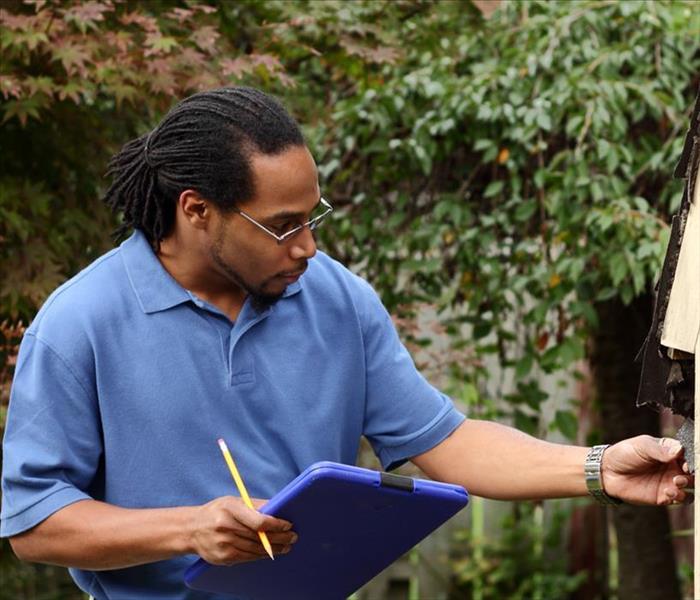 Roof inspection in Tusculum, TN
Roof inspection in Tusculum, TN
What To Do When Your Roof Experiences High Winds and Hail Damage
After experiencing high winds and hail damage to your home, there are many things you need to think about when it comes to roof repair. Here are two of the main actions you should take after a storm hits your property and causes serious damage to your house's roofing.
1. File a Claim After the Storm
In order to file an insurance claim after the storm, it is key to make a note of the exact date and time the storm and wind damage took place if possible. It is also wise to take high-quality pictures of the house, yard, and entire property, focusing in on any areas that are damaged.
Grab a pair of binoculars and use them to check out the roof shingles to see if they experienced any damage. Another good idea is to get a tape measure, place it next to one of the hailstones on the ground, and take a picture to provide to the insurance company. This can prove just how big the hailstones were during the storm.
2. Have a Roof Inspection
If you think you are in need of roof repair in Tusculum, TN, it is a good idea to contact a quality roofing company to perform an inspection on the home. The contractor should be able to estimate exactly how much damage took place and how much the repairs will cost. It is important that you do not try to perform the inspection on your own. Only a professional knows how to do this without getting hurt or causing more roof damage in the process.
After the storm takes place, one of your first priorities should be to assemble and file an insurance claim before it is too late. It is also wise to have a professional storm damage assessment take place to ensure that your roof and the rest of your home is safe.
4 Ways to Use Landscaping to Prevent Water Damage to Your Home
7/9/2019 (Permalink)
 Using a garden might be a great choice for you
Using a garden might be a great choice for you
Four Ways to Prevent Water Damage to Your Home
If you live in an area in Albany, TN, that is often experiencing outside flooding, it can be difficult to keep the water from damaging your home. However, there are ways that you can use your yard to help protect your house. Use the following tips to keep water where you want it and prevent it from going where you don’t.
1. Divert Water From Rain Spouts
One easy way to keep your home free of unwanted water is to redirect the rain drainage with a spout diverter. This convenient tool allows you to keep the water away from your walls and prevent flooding in the area.
2. Plant a Garden
If you have a green thumb, then using a garden might be a great choice for you. Choose plants that have a high tolerance for wet soil as the rain will pool in this area during a storm. This will keep the water from building up too much in other areas and causing unwanted outside flooding.
3. Use Heavy Mulch
When using mulch in your yard, opt for a heavier variety. Using lighter mulch means that it is more likely to be carried away to other areas during a rain storm. This can cause drains to clog and may result in water pooling in unintended areas.
4. Take Advantage of Your Yard’s Natural Landscape
If you have an area in your yard that naturally moves water in a certain direction, you can use this to your advantage. Place stones and plants to help direct the rain into a safe location.
While it can be frustrating to live in a location with frequent outside flooding, you don’t have to just accept damage to your home. Use these tips to prevent and limit its effect on your house. If your home is still affected, you can call a water damage restoration company to perform remediation and repairs.
How To Stock Your First Aid Kits
5/3/2019 (Permalink)
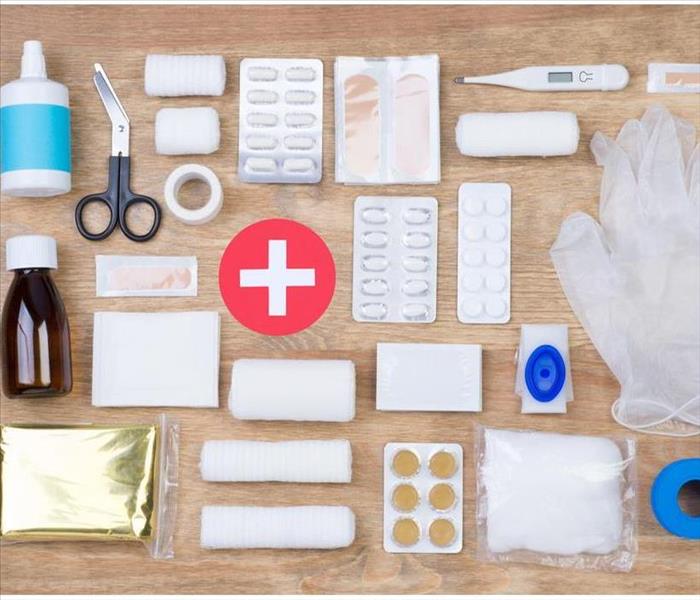 Kit supplies
Kit supplies
Do You Know What Items the Kits in Your Business Should Include?
Business owners are often reminded that they need a first aid kit on every floor of their buildings. Do you know what items the kits in your business in Greene County, TN, should include? Check all the kits in your building to make sure they are fully stocked according to the following five categories.
1. Wound Care Essentials
Every emergency kit should have the materials you need to bandage wounds and keep them clean during storm cleanup. You need various shapes and sizes of sizes of gauze pads and bandages as well as any tape needed to secure them. You also need a product that can be used to clean wounds.
2. Resuscitation Supplies
Every kit should have a way to help people who aren't breathing until paramedics can arrive. These items may include a pocket mask and resuscitation bag. Your building may also be equipped with automatic defibrillators.
3. Various Tools
Splints are helpful for stabilizing broken bones until emergency services take over. You may need scissors to trim gauze or tape to the right size to fit a wound. Tweezers can be a helpful addition to your first aid kit, too.
4. Blanket
When people get hurt, they sometimes go into shock. Having a blanket nearby can help them stay warm and help regulate their body temperature.
5. Emergency Assistance Information
When there is flood damage to your building, those who are trapped inside may need to call for emergency assistance. This includes not only medical help but also flood cleanup experts to stop the problem from getting worse.
Keeping every first aid kit in your building should be near the top of your priority list, especially during storm season. You may not be able to keep storm damage from happening in your building, but you can take the steps you need to take care of your employees and visitors if problems arise.
No Flood Insurance? Here’s What To Do
4/25/2019 (Permalink)
 A flood can be stressful for any homeowner. Not having flood insurance can make such a disaster even more worrisome.
A flood can be stressful for any homeowner. Not having flood insurance can make such a disaster even more worrisome.
Did a devastating flood recently hit your home, and you are left feeling helpless because you do not have flood insurance? Help is available if you lived through a federal disaster. Keep reading for more information on applying for federal assistance.
FEMA Grants
If you live in a disaster-designated county, you may be eligible for this coverage. These grants can help you and your family afford the following expenses:
- Medical and dental care for issues that were caused by the flood
- Home repairs related to the flood
- Underinsured and uninsured loss of personal property
- Funeral expenses necessitated by the flood
- Temporary housing needs
There are other expenses that may be covered as well. If you live near a flood plain and recently experienced a disaster related to it, it is time to visit www.fema.gov to learn more about the federal flood insurance application process. Be prepared for a federal inspector to visit your property.
Cleanup Assistance
If you need help with water damage in the meantime, a Greeneville, TN residential storm damage restoration specialist should be able to help. Most companies have technicians that are used to emergencies of this kind and can quickly set up a cleanup plan that will put your home on the path to recovery. If you are worried about being denied your federal insurance, know that you should still be covered for any damage as long as you take before and after pictures and save your receipts from repair work.
Help Is Available
A flood can be stressful for any homeowner. Not having flood insurance can make such a disaster even more worrisome. The best plan of action after a flood is to visit the FEMA website and learn about your coverage options - and to seek professional cleanup assistance from a storm damage company. Help almost always exists after a regional tragedy. You just need to have a plan in place, so you know where to find it.
Using the Right Equipment To Remove Water After a Flood
2/19/2019 (Permalink)
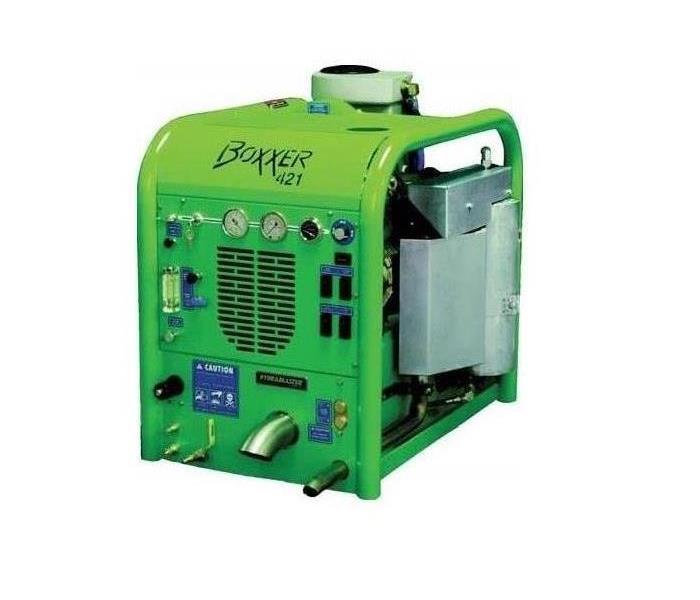 Truck mounts are useful because the pumps can remove more water
Truck mounts are useful because the pumps can remove more water
Water Removal Equipment
After surviving a flood in Greeneville, TN you make be left with a significant amount of standing water in your building. Whether you are left with two inches or two feet of water, your first priority is draining it to reduce the amount of water damage to the building. To remove several feet of water from your property, you need the right equipment. A sump pump or a trash pump could help you drain the water quickly and efficiently so that you can begin the restoration process. Most professional restoration companies have what you need.
Sump Pumps
Using a sump pump may be most beneficial for people who have basements. This type of flood equipment removes water and promotes quick drying in low areas of the commercial building. Offices in an area with a high risk of floods may choose to install the pump before a flood so that the water is removed as it fills the building.
Trash Pumps
Using a trash pump is especially useful after floodwater enters a property because this type of pump is designed to move a variety of trash mixed in with the water. Floodwater can contain numerous foreign substances, including those on the following list:
- Sticks
- Leaves
- Sewage
- Mud
- Sand
This is helpful because you are not left to clean the waste after the water has been removed. The trash is disposed of and the cleanup can continue without a problem.
Truck Mounts
Truck mounted equipment can be useful because the pumps can move more water. When you are trying to remove several feet of water, this may be the best solution because you can dispose of all of the water at one time instead of relying on a smaller pump.
Cleaning up after a flood in Greeneville, TN is a devastating experience, but using the right equipment can help you get on the right track quickly. When you need to remove a substantial amount of water from your business, consider using a truck-mounted pump, sump pump, or trash pump to help complete the job as quickly as possible. Visit http://www.SERVPROgreenecounty.com for more information on flood damage.
What To Do If Heavy Rains Cause Sewage Backup
2/19/2019 (Permalink)
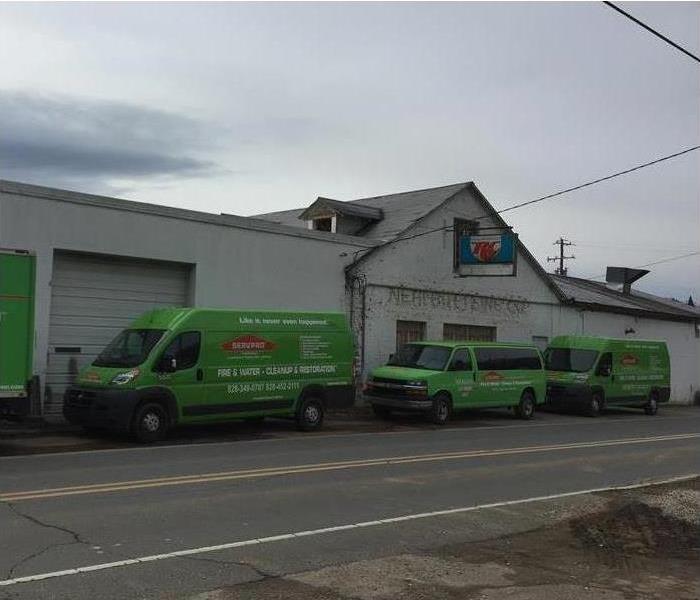 SERVPRO of Greene County is ready to help!
SERVPRO of Greene County is ready to help!
What To Do If Heavy Rains Cause Sewage Backup
Lots of rain water can wreak all kinds of havoc in your home. Not only can the water itself cause damage, but it can also lead to mold. Worse yet, sewer backup can cause black water to come into your home. This water is dangerous and contains all kinds of toxins.
If sewage backup comes into your home, take these steps:
- Get your loved ones and pets to dry ground
- Avoid going into the water at all costs
- Call a professional cleanup crew to extract the water
You may also want to take pictures of the damage to show your insurance company and keep a record. Remember that some restoration companies in Greeneville, TN are open 24/7, so you can call anytime you need help.
What To Do After the Water Is Gone
Even after the cleanup crew has extracted the water, the affected area should be treated as dangerous. Anywhere that sewer backup touched can be contaminated. You should work with your trusted professional restoration crew to understand what to do next.
You may need to dispose of certain items. If your belongings are porous, they could have raw sewage in them that never comes out. Be sure to check with authorities in Greeneville, TN to see how to best dispose of these belongings. Nonporous things may be saved with a bleach solution.
How To Prevent It
It’s better to prevent this problem from happening than to deal with it after the fact. You may wish to have an expert install a backwater valve that can keep sewage from coming into your home after a big storm.
Sewer backup and black water can be destructive forces in your home. You can take steps to help prevent this, but there is never a guarantee. If rain water causes this issue for you, call a professional immediately to prevent infection, mold, and other problems. Visit http://www.SERVPROgreenecounty.com for more information on storm damage.
10 Items That Should Be in Every Business’ First Aid Kit
2/12/2019 (Permalink)
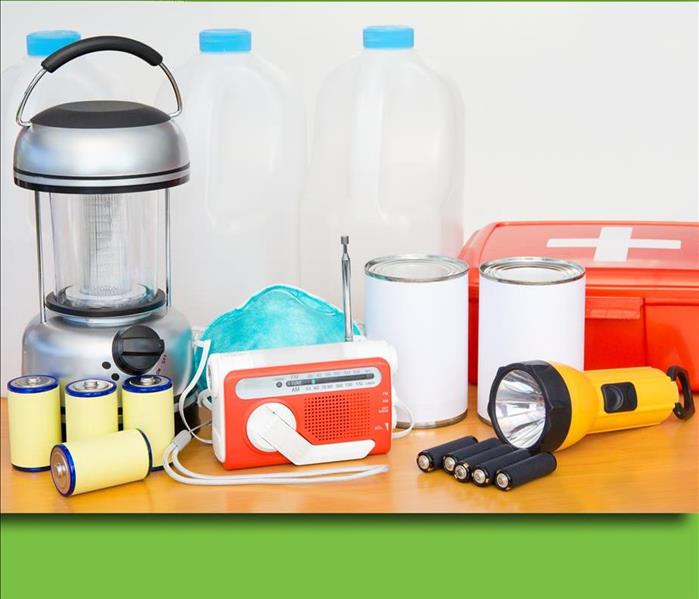 Be prepare with your emergency kit.
Be prepare with your emergency kit.
10 Necessary Items For An Emergency Kit
If someone is seriously hurt in your company’s building in Greeneville, TN, it is important you have the right tools to help address common injuries while waiting for first responders or a disaster recovery team to arrive. Check your first aid or emergency kit for these 10 necessary items.
- Gauze Pads: With this essential item, make sure you can appropriately dress wounds of various sizes without risk of painful sticking from bandage adhesive. Keep several different sizes on hand.
- Bandages: Hold dressings in place or easily take care of smaller bleeding wounds by stocking plenty of bandages. Include Band-Aids, gauze roller bandages, triangular bandages, and elastic wraps.
- Wound Cleanser: Keep antibiotic cream or sealed cleansing wipes to clean wounds and prevent infection.
- Gloves: Have gloves in your first aid kit to prevent the spread of bodily fluids. Consider latex-free gloves in case of an allergy.
- Scissors: Include scissors in your emergency kit to cut bandages. There are medical safety scissors created for this exact use you can buy.
- Blankets: Keep at least one blanket in your first aid kit in case one is needed to help someone stay warm and retain body heat. There are emergency blankets on the market designed to be effective while taking up minimal space.
- Tweezers: Ensure tweezers are available to remove debris from wounds, address splinters, or to take out bee stingers.
- Adhesive Tape: Easily secure bandages with the use of adhesive tape that is latex free.
- Resuscitation Equipment: Include CPR masks made for adults and infants, resuscitation bags, or disposable airway kits.
- Splint: Avoid any further damage or added pain to a broken bone or injured body part with a splint. This can prevent movement until a medical professional arrives.
You never know when an emergency might occur or how long it will take for help to arrive. Make sure your workplace is prepared by keeping all these important items in your business’ first aid kit.
How FEMA Helps After a Storm
7/20/2018 (Permalink)
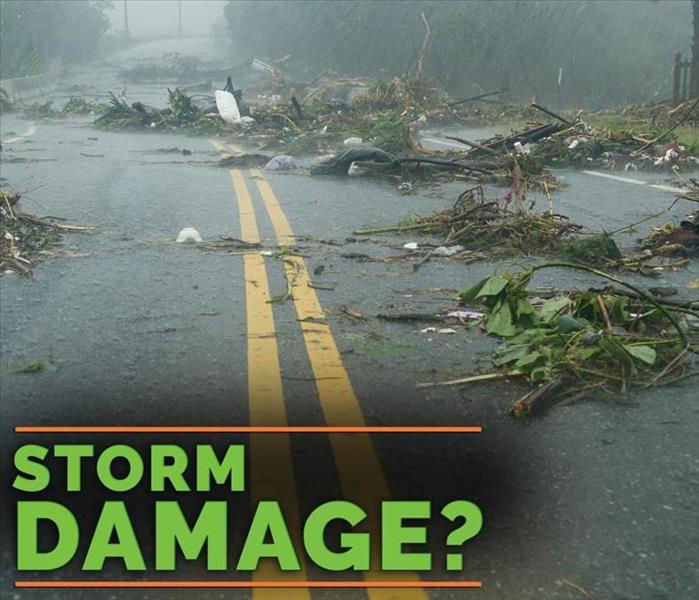 A flood, tornado, hurricane, mudslide, earthquake or wildfire is an event outside your control.
A flood, tornado, hurricane, mudslide, earthquake or wildfire is an event outside your control.
If a disaster were to strike your property in Greeneville, TN, you may be entitled to federal assistance. America’s Federal Emergency Management Agency (FEMA) was created in 1979 to help our country’s citizens prepare for and cope with natural and manmade disasters. The agency not only provides emergency shelter, it also teams with inspectors to assess damage to people’s homes and determine eligibility for many kinds of financial assistance.
How Federal Assistance Works
In the aftermath of a disaster in which federal assistance has been activated by the U.S. President to help victims, there are a few actions homeowners can take to move the process along. Self-advocacy is key to getting the ball rolling.
• Reach out for government assistance through your local disaster assistance center or by visiting www.disasterassistance.gov to determine what kind of help is available. There will be an application process.
• Provide proof of identity and ownership of the damaged property. The deed to the home must be kept in a safe place, perhaps offsite.
• A FEMA inspector will tour your home, obtain a list of current residents, document losses associated with events such as high winds and flooding, and ascertain the status of your home insurance.
If you are deemed eligible for a grant, you will receive a check or direct deposit along with a letter with directions for its use. If you do not qualify, you will receive a letter of explanation and an opportunity to appeal the decision.
A flood, tornado, hurricane, mudslide, earthquake or wildfire is an event outside your control, and once the federal government is compelled to respond, FEMA officials can step in to help. Because of the scale of these kinds of disasters, many of your neighbors will be seeking help at the same time. Patience, organization, and perseverance will be required in your shared recovery efforts. For more information, visit http://www.SERVPROgreenecounty.com/.
Flooding and Mold: The Noxious Duo
6/12/2018 (Permalink)
 After the cleanup is complete and the mold growth has been eradicated, watch for any new growth.
After the cleanup is complete and the mold growth has been eradicated, watch for any new growth.
Flooding in Greeneville, TN, is often a problem far bigger than the standing water left after the floodwaters have ebbed. Since many buildings soak up the water like sponges, it is no wonder mildew and mold growth can become a problem after a flood; thus, create a disaster scenario of their own.
Creative Mold
Molds are fungi that have existed for many thousands of years. Designed by nature to breakdown and recycle most organic materials, they can be very good at destruction. Wet or damp areas created by a flood can support mold growth and produce an effective breeding ground within 24 to 48 hours. Since there are more than 100,000 types of mold, it can difficult to know which will grow in what area, so it is advisable to contact a mold remediation team if the building shows signs of an infestation.
Hidden Water
As flood waters rush into the building, it can do much more than fill the center of the room. Hidden spots of water can often be found in:
• Bricks
• Sheet rock
• Wood
These items can soak up the water and stay wet for weeks. Standing water can also continue to soak into unseen areas causing hidden water problems.
When two feet of water fills a room, the actual water damage line can be as much as a foot higher. The space between the sheetrock and studs within the interior of the building can also fill with water and begin soaking into the structure’s wooden and cement foundation. The hidden water will often continue to erode the building’s integrity, hide dangerous bacteria, and allow for the growth of a destructive mold.
Patient Observation
After the cleanup is complete and the mold growth has been eradicated, watch for any new growth. Since mold can form and reproduce in as littles as 48 hours, checking often can be the best defense. If mold continues to be a problem, contact the professionals once again. There is probably a hidden pocket of moisture that continues to propagate the noxious duo of flood water and mold. For more information, visit http://www.SERVPROgreenecounty.com/.
6 Must-Know Sump Pump Maintenance Tips
4/13/2018 (Permalink)
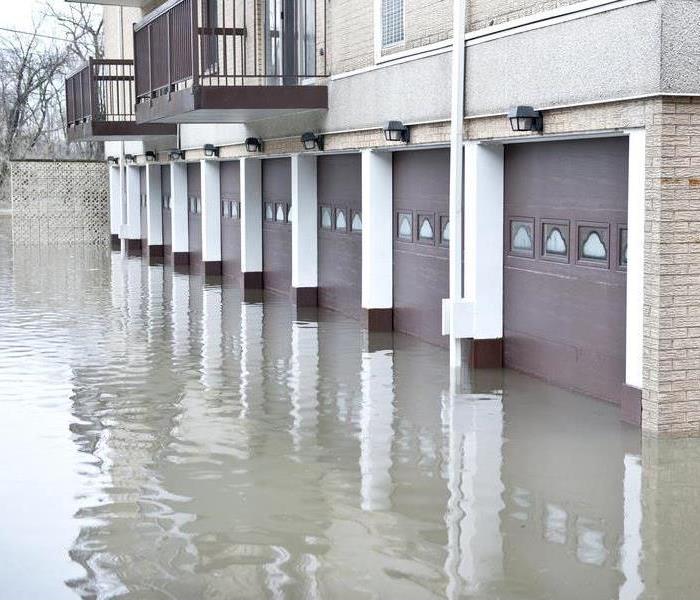
As a homeowner in Greeneville, TN, you may have a sump pump installed in your basement in case there is ever a flood. This piece of equipment sucks up water in your basement and directs it to your home's yard. If you have this piece of equipment, you need to make sure to maintain it properly. Without the proper maintenance, your pump may not be in working order when a flood does occur.
1. Clean Intake Screen: Three or four times a year, you should take the time to clean the intake screen of your pump. This cleaning can help make sure the screen is not clogged with sediment.
2. Check Pump's Electrical Source: Odd things can happen to the power cord of your pump. Whenever you clean the screen, you may want to make sure the device is plugged in and has power.
3. Clean the Pump: At least once a year, you should take the sump pump out of the sump and give it a thorough cleaning and inspection. This can help you find minor repair problems and fix clogs.
4. Apply Grease: Some pumps have bearings that need to be greased occasionally. You can check your owner's manual to determine if this step is right for you.
5. Clean the Sump: While the pump is out, you may also want to clean out the sump. This is usually done to keep sediment from blocking the water's path.
6. Test the Pump: Take a bucket of water and dump it into the sump. The float should rise and turn the pump on. If this doesn’t happen, you may need to have a professional take a look.
Pump maintenance is an important part of owning a sump pump. When storms or burst pipes cause flooding in your home, this piece of machinery plays an integral role in keeping the flood damage minimal. Working with a storm damage remediation team is another great way to reduce storm damage. For more information, visit http://www.SERVPROgreenecounty.com/.
Disaster Preparedness in Greeneville, TN
2/19/2018 (Permalink)
Disaster preparation includes making sure that the water damage and fire damage does not cause too many problems in the house. There are a few steps to follow, and it helps people to be sure that they will protect their homes and their investment.
- Disaster Preparedness around the house.
- Having a mitigation company in mind.
Someone who is planning to be ready for a disaster needs to be sure that emergency services are not needed when a disaster comes to the house. Everyone who has been hit by something that causes fire damage and water damage needs to be sure that they have called the mitigation company in Greeneville TN, Tusculum TN or Afton TN.
SERVPRO of Greene County is always available to help. Visit our website for more information.
Preparing Your Home for a Storm
2/19/2018 (Permalink)
Disaster Preparation Around The House
The preparation that is done around the house has to include waterproofing that will prevent water from flooding the lower levels of the house, and it should also include fire retardant materials that help prevent the house from catching on fire when it gets too hot or the fire comes to the house.
This can give people a chance to take action to protect the house when there is a disaster happening in the area. Each of these small things will make a big difference, but there could still be damage in the area because of the disaster.
Everyone who is looking for a way to recover from a major disaster should be sure that they have work with the right company to fix the house. They also have to make sure that they are prepared for what could come. There are things that can be done to the home to make the houses function well, and it will increase the chances that the house will survive if there is a problem. Just making sure that the house is ready for a disaster in case it comes, or that is can be repaired when something bad happens.
SERVPRO of Greene County is always available to help. Visit our website for more information.
Mitigation After Storm Disaster
2/19/2018 (Permalink)
How Do Mitigation Services Work?
Mitigation services work just like any other kind of repair, and they need to be sure that they have found a company in the area that can come out as soon as they need them to. The company can offer the emergency services in Greeneville TN, Tusculum TN and Afton TN, and they will move so fast that they can help them get the house to come back to its original condition. Homeowners are trying to recreate the way the home looked because the storm or the fire came through the area.
Everyone who needs these services needs to be sure that they will be able to get the help that they need so that the people who are fixing up the home can see the home return to its former glory. Planning for this means knowing when to call the company to come out, and it also involves making sure that the company knows how bad the damage. They can offer a timeline that will be easy to follow, and they will show the client how easy it is to get all the damage out of the house.
SERVPRO of Greene County is always available to help. Visit our website for more information.
Professional Storm Damage Restoration: Why is it Crucial?
9/25/2017 (Permalink)
Professional Storm Damage Restoration: Why is it Crucial?
Just like any other natural calamity, a storm is unpredictable and it brings forth devastating effects. After a storm hits an area of residence, it is imperative to call a water restoration or storm restoration company to remediate the storm damage. Storm and flood damage can cause grave damages to residences and immediate response to the storm damage and flooding conditions is necessary to avoid costly home restoration costs.
When it comes to storm damage, a storm restoration company with the right credentials and experience to deal with this natural disaster is the best to approach. The damages caused by a storm cannot be handled by the affected parties, rather, it need be handled by skilled professionals who specialize in storm remediation. This is because a storm can be accompanied by hurricanes, heavy wind, ice flows, and hailstorms. These factors in turn result to hurricane damage, wind damage, ice damage, and hail damage respectively.
Storm restoration requires proper assessment to determine the extent of the damage in homes in order to come up with a suitable action plan for storm remediation. When the storm is especially heavy, it may even cause ground water to leak causing massive flooding. Flood water in homes can leave properties in a terrible state, and more so, flood water is known to destroy personal belongings such as furniture leaving them in irreparable state. This will mean incurring more costs in the home restoration process.
After the storm restoration company inspects the damaged property and develop a suitable plan, they start by removing the debris that may have been swept to the affected residence by flood water. Moreover, the wind accompanying the storm can cause immense roof damage. If there is a roof leak or the roof has caved in, restoration experts will need to clear off the bricks that have been damaged before carrying out the storm remediation.
During a storm, there is usually heavy rain that could lead to river flooding. When river flooding occurs, the water bursts out of the banks carrying with it debris and other material that could cause extreme flood damage on residential property. When river flooding and ground water combine, they cause heavy flooding and owners may be required to vacate their premises until water restoration is carried out.
After a storm, flood water may cover the floor, cause burst pipes and ground water. In a home restoration process, the storm and water restoration experts need to mitigate these damages as soon as possible. This is essential because flooding can render a residential property uninhabitable due to extreme structural damage.
This flood water can be removed using a submersible flood pump. The flood pump removes the flood water from the floors discarding it elsewhere. The flood pump utilizes the suction method to pump out water. If a residence is affected by flooding, whether caused by river flooding, ground water, or burst pipes, the professionals have to have a flood pump for successful water restoration.
When an ice damage or a storm damage occurs, there can be extreme ice damage and hail damage in homes. Ice falling on roofs could lead to ice dams and in turn roof damage. An ice dam prevents melting water from draining off the roof, and the water left behind the ice damming can lead to roof leaks that in turn translate to roof damages. Ice dams are caused by snowstorms. This ice damming causes cracks on roofs resulting to roof leaks.
Ice damage and hail damage after a storm not only cause ice damming but could also lead to frozen pipes. Home restoration services ought to entail remediating the frozen pipes. Home restoration companies offer immediate relief by fixing the frozen pipes and reinforcing them. Frozen pipes have devastating outcomes when left unattended.
Roof leaks call for roof repair regardless of whether they are caused by an ice dam or a serious roof damage caused by wind damage and hurricane damage. Strong winds cause both wind damage and hurricane damages that necessitate a roof repair. If roof repairs are not catered for appropriately, secondary damages could occur. Each roof repair incidence requires a different approach depending on the cause of roof leaks and roof damage. Regardless of whether the damage emanated from an ice damming, a wind damage, a hail damage, or a hurricane damage, a proper home restoration must incorporate a roof repair among other repairs associated with a storm remediation.
Visit http://www.SERVPROgreenecounty.com for more information on storm damage.

 24/7 Emergency Service
24/7 Emergency Service
















